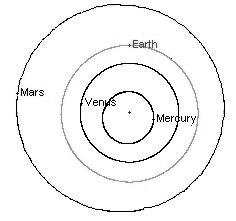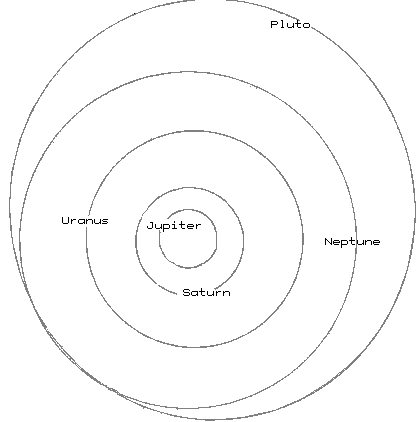
Formation of the Solar System
Summary
Any model of the formation of the solar system must account for the motions, compositions and locations of all the planets and their moons. In this lab, you will use the motions of objects in the solar system to concoct a model of the formation of the solar system.
Processes which were important to the formation of our solar system are also important in star formation, and galaxy evolution, so we will be visiting many of these concepts again.
Procedure
 Part 1: Shapes of Planetary Orbits
Part 1: Shapes of Planetary Orbits
- Examine Figure 1, which shows the orbits of the inner planets. In general, what shape are the inner planet orbits?
-
Examine Figure 2, which shows the orbits of the outer planets. In general, what shape are the outer planet orbits?
- Which of the planet orbits is different from the others? What are two ways in which the odd orbit is different from the others?
Part 2: Inclinations of Planetary Orbits
- The inclination of an orbit is the angle between the orbit and the plane of the solar system. For example, the inclination of the Moon's orbit is 5o, because the orbit of the Moon makes a 5o angle to the orbit of the Earth around the Sun. Examine Table 1. Which planet has the largest inclination?
TABLE 1: Rotation and Revolution Data
| Planet |
Planet Revolution |
Inclination of Orbit |
Planet Rotation |
Moon Revolution |
Moon Rotation |
Planet Density |
| Mercury |
CCW |
7 |
CCW |
No moons |
No moons |
5.4 |
| Venus |
CCW |
3.4 |
CW |
No moons |
No moons |
5.2 |
| Earth |
CCW |
0 |
CCW |
CCW |
CCW |
5.5 |
| Mars |
CCW |
1.9 |
CCW |
CCW |
N/A |
3.9 |
| Jupiter |
CCW |
1.3 |
CCW |
CCW |
CCW |
1.3 |
| Saturn |
CCW |
2.5 |
CCW |
CCW |
N/A |
0.7 |
| Uranus |
CCW |
0.77 |
CCW |
CCW |
N/A |
1.3 |
| Neptune |
CCW |
1.8 |
CCW |
CCW |
N/A |
1.6 |
| Pluto |
CCW |
17 |
CCW |
CCW |
N/A |
2.1 |
- Why is the Earth's inclination exactly 0?
- How do the orbital inclinations of the inner planets compare with those of the outer ones?
- In one sentence, describe the shape of the solar system, using your answers from Part 1 and Part 2.
Part 3: Rotations of the Planets
- Examine Table 1. Answer the questions on the worksheet.
Part 4: The Composition of Planets
- Different types of substances are solid, liquid or gas at different temperatures. For example, things like iron remain solid even at quite high temperatures (a few thousand degrees), whereas water becomes a liquid at 0oC, and other molecules that form ices, such as ammonia and methane, don't become solid until extremely low temperatures, approximately -150o C.
Consider the temperatures of the early solar system. Was the outer solar system colder or hotter than the inner solar system?
- Was iron a gas, liquid or solid in the inner solar system? In the outer solar system? How about water? Ammonia or methane? Fill in the table on the worksheet with this information.
- Gases are easily blown around by the solar wind, which is strong near the Sun, but gets weaker and weaker the further away you are from the Sun. What happened to the ammonia and methane in the inner solar system? What happened to the ammonia and methane in the outer solar system?
- In one sentence, describe the distributions of compositions in the solar system. This distribution must be accounted for in a model of the solar system, and of solar system formation.
Part 5: The Standard Model
The standard model of the formation of the solar system begins with an enormous cloud of gas and dust, which is slowly rotating counterclockwise. The cloud begins to collapse under gravity. This spinning cloud has angular momentum (like an ice skater), and so it collapses more easily along the axis than towards the axis.
During this time, the particles can slip past each other easily, since the cloud is not very dense. Later, when the solar wind begins to blow, the inner solar system loses much of its low-density (icy) material, which has remained in gaseous form. This material winds up in the outer solar system, on the moons and in the atmospheres of the gas giant planets.
As the cloud collapses, it becomes denser. Particles to begin to collide, and sometimes stick together, forming larger particles. These larger particles are orbiting the center of the cloud counterclockwise, because the smaller particles were traveling in that direction. The collisions with particles moving slightly outward in their orbits are as common as collisions with particles moving slightly inward in their orbits, causing the orbit of the growing body to become more and more circular, and less elliptical.
The cloud continues to collapse because of gravity, and to spin faster because of the conservation of angular momentum. Eventually, most of the large particles have been gathered up into a few large bodies, and continue adding mass by running into lots of smaller particles.
We have now accounted for the shape of the orbits, the shape of the solar system, the rotations of the planets, and the distribution of densities. All with a very simple model of a cloud which collapses under gravity, and conserves angular momentum. However, this is far from the whole story. It works pretty well for our solar system, but fails when applied to the dozens of planets around other stars which have been discovered in the last decade.
- What would happen if the original cloud were too large and too low-density for gravity to be important?
- What would happen if angular momentum was not conserved?
- How might you explain Venus' counter-rotation? Feel free to engage in wild speculation. This is an unanswered question in astronomy!
- How might you explain the oddities of Pluto's orbit? These irregularities are among the main reasons that many astronomers prefer not to consider Pluto a planet at all, but a captured comet instead.

 Part 1: Shapes of Planetary Orbits
Part 1: Shapes of Planetary Orbits